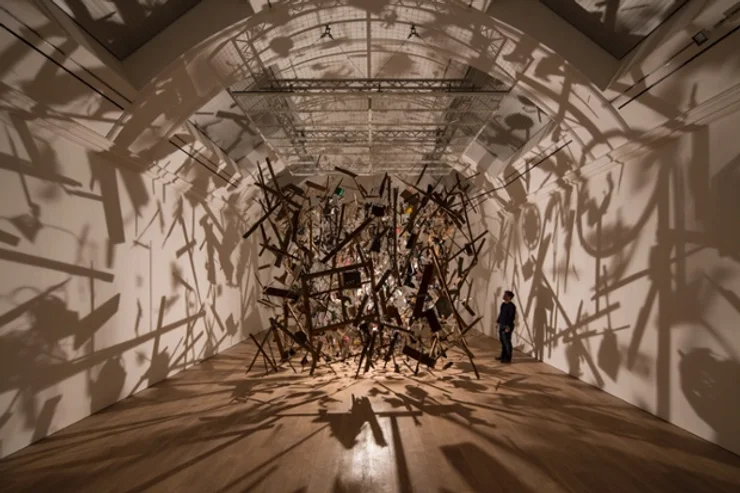By: Grace Ge
When British artist Cornelia Parker was a little girl, she would put a coin on a railroad and watch it get run over by a train. She watched the coin turn from something dull and boring into something amazing, a piece of art. She didn’t just squish a penny, she created a new amazing way to make art.
Ever since the late 1980s, Parker has been creating art using everything from plastic explosives to steamrollers, snake venom to the very blade of the guillotine that chopped off Marie Antoinette’s head.
This May, for Parker’s second survey, and her first major surveys of her work ever staged in London, Tate Britain gathered almost 100 pieces of art, from drawings make from sewing through paper, to a wire made of melted bullets. Tate Britain is also featuring the big exploded pieces of art that brought Parker to fame, including a garden shed she convinced the British Army to help her blow up into bits in 1991.
Parker’s works often include exploding, crushing, and other similar methods. She is especially famous for Cold, Dark Matter: An Exploded View. This is the garden shed that she asked the British Army to blow up for her in 1991. The shed is suspended by invisible filaments. In the center, there is a bright light bulb, casting shadows around the room. The piece of art looks like as if someone caught a 3D picture of a garden shed exploding, but the shed was still oddly square-like. And the shed seemed as if it were in space, and was frozen in place as well. The shadows were scattered around the room, as if someone used a hair dryer to blow the shadows everywhere. The shadows look as if a woodworker has its materials spread all over the table in a mess. The shed looked messy with all of its pieces in its cube shape, but the cube itself was very neat.
She also sort of redesigned a sculpture made by French sculpture Auguste Rodin, by wrapping a mile of string around it. She renamed it The Distance (A Kiss with Strings Attached). There is actually a prank where an artist also used a mile of string to fill the inside of a museum, making it awkward and hard to see all the art. But Parker didn’t just imitate a prank, she obscured and accented Rodin’s work, showing the tautness and slackness in the strings, causing us to see the sculpture in a completely different way. Does the string bring the two people together, or is it keeping them there like a prison? The string-wrapped statue plays with your mind and eyes, making it abstract, yet tangible at the same time.
For Thirty Pieces of Silver (1988-89) Parker ran a steamroller over more than 1,000 pieces of silver and silver-plated objects, from teapots to trombones and to baby spoons. Then she arranged them into 30 groups. Then she dangles the silver from long wire a few inches from the floor.
Over and over again, Parker uses explosives and steamrollers to destroy and rebuild her art; it all started because of a few little coins getting run over by a train. Parker is an important artist who introduced a new style of art. She destroys and reuses her materials, instead of simply chipping out a piece of stone, or painting a line of color on a surface. Parker makes destructed items beautiful, when they could have been ugly.
Source: https://s3.amazonaws.com/appforest_uf/f1656024503937x897509551200573700/Cornelia%20Parker_%20The%20artist%20who%20likes%20to%20blow%20things%20up%20-%20BBC%20Culture.pdf











